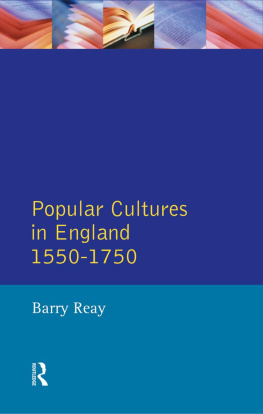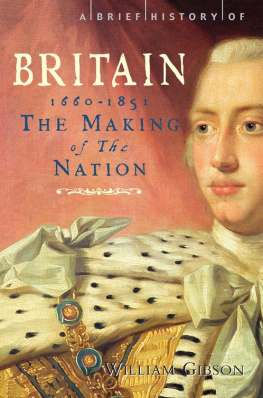SEMINAR STUDIES IN HISTORY
General Editor: Roger Lockyer
Radical Puritans
in England
15501660
R. J. Acheson
First published 1990 by Longman Group Limited
Third impression 1994
Published 2013 by Routledge
2 Park Square, Milton Park, Abingdon, Oxon OX14 4RN
711 Third Avenue, New York, NY 10017, USA
Routledge is an imprint of the Taylor & Francis Group, an informa business
Copyright 1990, Taylor & Francis.
All rights reserved. No part of this book may be reprinted or reproduced or utilised in any form or by any electronic, mechanical, or other means, now known or hereafter invented, including photocopying and recording, or in any information storage or retrieval system, without permission in writing from the publishers.
Notices
Knowledge and best practice in this field are constantly changing. As new research and experience broaden our understanding, changes in research methods, professional practices, or medical treatment may become necessary.
Practitioners and researchers must always rely on their own experience and knowledge in evaluating and using any information, methods, compounds, or experiments described herein. In using such information or methods they should be mindful of their own safety and the safety of others, including parties for whom they have a professional responsibility.
To the fullest extent of the law, neither the Publisher nor the authors, contributors, or editors, assume any liability for any injury and/or damage to persons or property as a matter of products liability, negligence or otherwise, or from any use or operation of any methods, products, instructions, or ideas contained in the material herein.
ISBN 13: 978-0-582-35515-6 (pbk)
British Library Cataloguing in Publication Data
Acheson, R.J. (Robert J)
Radical puritans in England, 15501660. (Seminar studies in history).
1. England. Puritanism, history
I. Title II. Series
285.90942
Library of Congress Cataloging-in-Publication Data
Acheson, R. J.
Radical Puritans in England, 15501660/R. J. Acheson.
p. cm. (Seminar studies in history)
Bibliography: p.
Includes index.
ISBN 0-582-35515-X
1. Separatists England History 16th century. 2. Separatists England History 17th century. 3. Puritans England History 16th century. 4. Puritans England History 17th century. 5. England Church history 16th century. 6. England Church history 17th century. I. Title. II. Series.
BX5203.2.A28 1989
274.206 dc20 | 89-8058
CIP |
Set in 10/11 point Baskerville (Linotron)
Contents
Founding Editor: Patrick Richardson
Introduction
The Seminar Studies series was conceived by Patrick Richardson, whose experience of teaching history persuaded him of the need for something more substantial than a textbook chapter but less formidable than the specialised full-length academic work. He was also convinced that such studies, although limited in length, should provide an up-to-date and authoritative introduction to the topic under discussion as well as a selection of relevant documents and a comprehensive bibliography.
Patrick Richardson died in 1979, but by that time the Seminar Studies series was firmly established, and it continues to fulfil the role he intended for it. This book, like others in the series, is therefore a living tribute to a gifted and original teacher.
Note on the System of References:
A bold number in round brackets (] refers the reader to the corresponding item in the section of Documents, which follows the main text. A word followed by an asterisk, for example, Baptist*, indicates that the term is defined in the Glossary.
ROGER LOCKYER
General Editor
Cover: Radical Puritans in England 15501660 painting of a Quaker meeting by Egbert van Heemskirk (16451704) showing a woman preaching. By courtesy of the Religious Society of Friends, London.
This study attempts to guide the student of religious tensions in Early Modern England through the complexities of radical thought and action associated with that period. Naturally, in a study of this length, oversimplification will occur and the use of the word Puritan in the title of this book exemplifies this. This volume concentrates upon religious separatists; it would be true to say that whilst most separatists prior to the Civil War were either Puritan or, at the very least, shared a common Puritan ancestry, not all Puritans were or became separatists.
It is normal to claim responsibility for all errors and omissions and this I gladly do. Likewise, due credit should be given to those who have helped me avoid many more. John Faulkner first started me on the path of separatist study and Patrick Collinson lit the way, opened perspectives, and always encouraged; I am deeply grateful to them both. My former colleague, Richard Wright, proved an excellent and critical sounding board, whilst my last A Level set at the Duke of York's RMS in Dover kindly and patiently put up with my early ramblings on this theme.
The staff of various libraries particularly those of the British Library, the Cathedral Library at Canterbury, the Dr Williams' Library, and the Society of Friends' Library at Euston all proved indispensable. The editor of this series, Roger Lockyer, has made a telling contribution to both the content of this volume and to the way in which it has been presented. To him I owe much and from him I have learnt a great deal.
Finally, I am indebted to my wife, who has placidly lived with religious radicalism for nearly a decade. To Jill, and her tolerance, this volume is dedicated.
Robert Acheson
1988
Part One: The Background:
The Radical Tradition
Throughout this volume, the term separatist is frequently employed. As a definition, however, it is open to misuse, and in this study it will be applied strictly only to those individuals or communities whose ideas about how the religious life of the nation should be organised differed from official views. In other words, separatists did not, for a variety of reasons, regard the Established Church as a true church. This being so, they felt impelled to separate themselves both physically and spiritually from what was for them a Church of confusion, where the Lord's people may not tarry (). This is a crucial distinction; there were many who regarded the services and even the theological position of the Church during the period in question with distaste, but not all such took the momentous step of total separation. The chronicler of the Broadmead separatist church notes this as late as 1640:
These few being thus joined, confirmed and separated, they began very much to increase But divers that were grave, sincere, and godly people, that had gone all along with them step by step until this, would not enter into church fellowship at that time, standing off for many years ().
This whole issue of attitudes was an important one, dividing nonconforming Puritans from semi-separatists, and both these from separatists as such. It drew a thin but very real dividing line between these respective groups which, in the face of the enforcement of episcopal discipline, might otherwise have been logical allies. Indeed, to anticipate one of the arguments put forward in this study (see ), it may be that the real achievement of Archbishop Laud's policy was for a brief but seminal time to forge an alliance between these sharply disparate elements.










